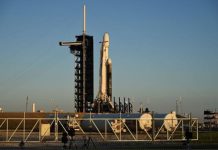
May 24 (UPI) — President Donald Trump is scheduled to travel to Florida on Wednesday to watch as SpaceX launches its Falcon 9 rocket and Crew Dragon spacecraft into orbit.
If the launch goes according to plan, it will be the first spaceflight launched from U.S. soil with American astronauts on board since 2011.
On Friday NASA and Space X completed a flight readiness review to launch NASA astronauts Robert Behnken and Douglas Hurley from Kennedy Space Center in Merritt Island in Florida.
Wednesday’s trip to Florida will be Trump’s first not directly related to the coronavirus pandemic in two months. He’s largely kept to the White House since March, when he declared a national emergency.
Vice President Mike Pence is also expected to attend. NASA and SpaceX are both urging spectators to stay home and watch the event online rather than gather to watch the launch in person.
But local officials — including Brevard County Sheriff Wayne Ivey — say they will not discourage members of the public from traveling to Merritt Island to watch the launch.
“I’m not going to tell Americans they can’t watch a great piece of history. I’m just not going to do it,” Ivey told CBS Miami this week.
The Falcon 9 rocket is owned by billionaire Elon Musk, who helms SpaceX and also is the CEO of electric car company Tesla.
Wednesday’s launch, then, marks the first manned space launch using commercially developed, privately owned spacecraft — as opposed to technology developed and owned by the federal government.
SpaceX has already sent uncrewed cargo Dragons on nearly two dozen missions to the space station.
The company is currently leasing the 39A Launch Complex, which will be used to send the spacecrafts into space.
Many previous Apollo and space shuttle missions were launched from 39A at Kennedy.
According to NASA, the exact duration of the mission has not been determined, but the Crew Dragon being used for this flight test can stay in orbit for about 110 days.
The operational Crew Dragon craft will be capable of staying in orbit for at least 210 days, in accordance with a NASA requirement.





